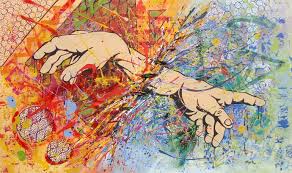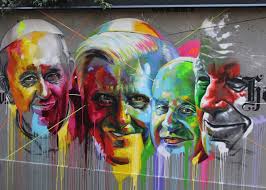Second Sunday of Easter, Divine Mercy Sunday
SECOND SUNDAY OF EASTER, DIVINE MERCY SUNDAY
“Unless I see the mark of the nails in his hands and put my finger into the nail marks and put my hand into his side, I will not believe.” Jn 20:24
Poor Thomas.
Peter denied Christ – not once, not twice, but three times! And yet, somehow his reputation was rehabilitated. We don’t call him “Denying Peter,” for example. No, he’s the Prince of the Apostles!
And how about Paul? He initially persecuted and murdered Christians. We don’t call him “Persecuting Paul,” though, do we? Instead, we call him a “Saint.”
Poor Thomas.
He speaks just four lines in the entire New Testament, all of it recorded only in John’s Gospel. But each one of his statements is a haunting, memorable one.
The first time we hear Thomas speak he says, “Let’s all follow Jesus … so that we may die with him.” Incredibly daring! So much so that we could call him “Courageous Thomas”- the man willing to die with Jesus.
But we don’t.
He then says, “Lord, we do not know where you are going, so how can we know the way?” To answer this insightful question from Thomas the Lord announces one of his most famous lines: “I am the way, and the truth, and the life.” A profound teaching! For this, we should be calling this future apostle “Wise Thomas.”
But we don’t.
The last words from Thomas’ lips are “My Lord and my God!” These words have become the culmination of John’s entire Gospel. So, one would think we’d call him “Professing Thomas.”
But we don’t.
Instead he has been forever known as “Doubting Thomas” – all because of the one other sentence he utters in today’s gospel reading:
“Unless I see the mark of the nails in his hands and put my finger into the nail marks and put my hand into his side, I will not believe.”
And so Thomas became forever remembered as the one who doubted because he had to see and even touch the wounds. For him, the only real proof of the resurrection is the wounds – not a poetic description of them, but an actual probing of real, torn flesh.
Thomas was not able to deal with resurrection as a metaphor, or a collective wish-dream. For him, Easter jubilation is false if it forgets the grotesque brutality of the powers of death. For Thomas, evil must be taken seriously. His refusal to believe his friends is not the fruit of intellectual skepticism but rather is rooted in his absolute anguish.
The world’s evil is monstrous. We read about and watch it every day – terrorism, starvation, human trafficking, homelessness, horrifying tortures of all kinds, and even the desecration of mother earth.
What Thomas is telling us is this: if the Christ whom the world killed is not deeply scarred by it, there is no real resurrection.
Today, in the world you and I live in, it is the community of believers, the church, that must testify to that very same thing. Only, for us, the wounds, the marks, the scars, that now matter are not the ones in Jesus’ hands and side, but rather the ones in our worshiping communities. So many of the stories we hear of people without faith include their disillusionment with a church that fails to make real what we profess.
Like Thomas so long ago, people today want to see the wounds. They want to see and they want to touch the wounds in our hands and in our sides, that is, the evidence that we are really connected to the Jesus who was crucified, the Jesus with the gaping holes where nails were pounded into his hands, the Jesus who underwent horrific torture.
Again, like Thomas, they’re not interested in a Jesus who can’t relate to the wounds we carry in our own bodies and in our own hearts. They can’t identify with a Jesus who is above it all, pure and untouched and unconcerned with human pain and suffering.
Our God is a God with wounds.
That’s why the great grace called mercy is so central to the gospel of Christ Jesus and to our own individual lives. Jesus tells us clearly in today’s gospel reading that our own wounds are acceptable; our own wounds are hallmarks of efforts to love; our own wounds – even sins, if you will – are what puts us in a place where, like Thomas, we can identify with the Lord.
We have wounds too. Each one of us. We have terrible scars that we carry. We have hurts and mutilations and heartaches and shame places that we so want to be touched and healed.
And what we see in this powerful Easter story is that all of these can be healed; all of these can be used by our God to lead us to a sense of identity with other wounded people; all of these can make us vulnerable to the possibility of personal transformation, of “resurrection” to a new way of living – the way of the Risen Lord who has gone before us beckoning, urging, pleading with us to follow.
Doubting Thomas is so important because he represents each one of us. He waited a week to confront the Lord. We maybe have waited many years. Thomas wouldn’t believe until he saw and touched. We usually won’t either – until we see with our own eyes people who call themselves followers of Jesus forgiving each other, until we see with our own eyes people who call themselves followers of Jesus refusing to live out of hate and fear, until we see with our own eyes people who call themselves followers of Jesus stop seeking revenge and stop acting out of meanness – and instead become instruments of mercy. Always mercy.
When that happens, even a little, even again and again, then we, like Doubting Thomas, can drop to our knees and say with him those words that ring down through the centuries and make a home in our hearts: “My Lord and my God.”
Ted Wolgamot, Psy.D.
11809194.1
4/20/19




